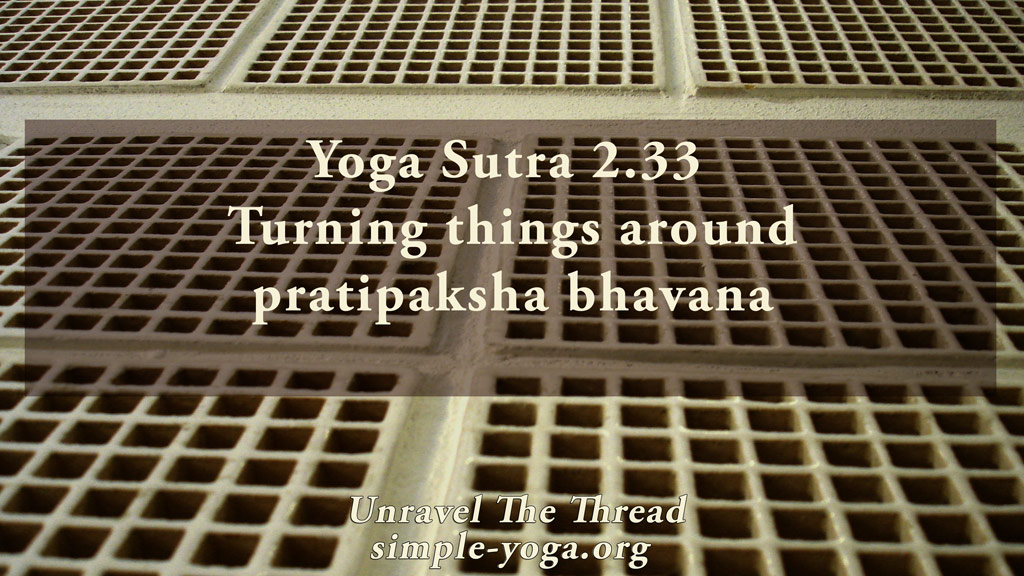
2:32 Niyamas: Humility – ishvara pranidhana
December 1, 2020
2.34 Abstaining from negativity and violence
December 1, 2020
2:32 Niyamas: Humility – ishvara pranidhana
December 1, 2020
2.34 Abstaining from negativity and violence
December 1, 20202.33 Turning things around (pratipaksha bhavana)

2.33 When unhelpful thoughts and emotions arise cultivate uplifting thoughts and emotions (pratipaksha bhavana).
After presenting the yamas and the niyamas, Patañjali introduces a useful technique for implementing them: cultivating the opposite or turning around your ways of being (pratipaksha bhavana). This technique is to turn our ways around to the measure that is possible for us. Remember that in sutras 1.20, 1.21, and 1.22 Patañjali offers attitudes for the practice (confidence, vitality, remembrance, evenness of mind, wisdom) and talks about levels of intensity in your commitment (mild, moderate and intense). As with anything else in life, you turn things around in the way that is most helpful, appropriate, and viable for you. Turning things around requires that you notice unhelpful patterns of movement, breath, thinking, emotion, and behavior. You are always a complete being; all your systems work together. However, sometimes there is better integration between your different aspects while other times you may feel fragmented and out of sorts. Consider becoming familiar with the ways in which your body, mind, and emotions are deeply interconnected. For instance, you can explore how thinking about something that makes you worried or anxious most likely will have some effect on your breathing. Similarly, when you regulate your breath, by making your breathing faster or slower, your body and mind will respond in specific ways. Paying attention to these relationships and connecting to the direct experience of sensing can indicate if a change of direction may be needed. At any point you can choose what patterns to emphasize or downplay. The effects will speak for themselves.
Remember that in sutra 1.39 Patañjali offered an option for removing distractions, consisting of focusing on anything uplifting. Along the same lines, another way of thinking about pratipaksha bhavana is as a suggestion to uplift. What happens when you choose uplifting and helpful ways of being? Redirecting your attention happens in one moment. It is an easy, simple and very specific action. The well-established patterns, however, will arise again soon enough, often, without your even noticing. Becoming aware of how deeply entrenched some habits are may trigger varying levels of frustration. The practice is to drop the unhelpful pattern as soon as you notice it and to choose an uplifting alternative. Before you know it, the unhelpful pattern may appear again. Notice that dropping the pattern is simple and easy; its recurrence tests your patience and resolve. It makes sense that the more established a habit, the sooner it will return.
Consider that the habit you are noticing may have taken a long time to get established. Recognize that removing the habit happens by releasing it and focusing on something else that is more uplifting and useful. You will probably have to go through the cycle of actions in the Method for Presence introduced in the Foundations of Yoga chapter – pausing, feeling, validating, clarifying, choosing, and responding many times. Some part of you may ask how many times? The answer is: as many times as the habit keeps returning. Regardless of the claims of most advertising, it’s highly unusual for anything to work instantaneously. Noticing that a pattern is appearing again is a sign that the pattern is moving from your subconscious to your conscious mind. Noticing the pattern also indicates that you are paying attention, and that the pattern is not who you are, because if the pattern were who you are, who is noticing the pattern? Whatever the pattern may be, it is something you have cultivated. That specific pattern may have been useful before, but once it is no longer beneficial, you choose to drop it, an intelligent choice. Once again, the four Ss are a vital skill to master to establish your new habit. Just remember to keep returning to the unique moment you are in without struggle, strain or self-judgment and with a gentle smile. By letting go of the pattern again and again, with gentle and patient persistence, you are developing a new, more helpful and uplifting pattern.
Some useful questions for exploration:
What patterns are you noticing in your posture and movements?
What patterns are you aware of in your breathing?
What patterns are prevalent in your thinking?
What emotional patterns seem to be common in you?
Are your aware of your interactional patterns?
Which of these patterns are helpful?
Which of these patterns are unhelpful?
What patterns are you turning around?
How soon do the unhelpful patterns return?
How do you feel when you turn a pattern around?
As usual, one more way of exploring the meaning of this sutra is by chanting it.
You can choose to chant it in its traditional form with some of the words coming together:
2.33 vitarkabādhane pratiprakṣabhāvanam
वितर्कबाधने प्रतिप्रक्षभावनम् ॥३३॥
Another option is to chant each word in the sutra individually:
- vitarkaḥ
- bādhane
- pratiprakṣa
- bhāvanam
If you prefer, you may listen to the podcast:
Unravel the thread is now available as a book!
If you find Simple-Yoga.org and Unravel the thread useful, consider supporting my labor with a donation, you may also donate using PayPal or Venmo. Thank you!
